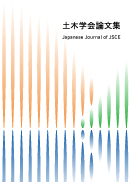Volume 81, Issue 6
Standard issue(Released in June)
Displaying 1-13 of 13 articles from this issue
- |<
- <
- 1
- >
- >|
Structural Engineering, Earthquake Engineering and Applied Mechanics
Paper
-
2025 Volume 81 Issue 6 Article ID: 24-00311
Published: 2025
Released on J-STAGE: June 20, 2025
Download PDF (1275K)
River, Coastal, Ocean Engineering and Hydorology
Paper
-
2025 Volume 81 Issue 6 Article ID: 22-00366
Published: 2025
Released on J-STAGE: June 20, 2025
Download PDF (6791K) -
2025 Volume 81 Issue 6 Article ID: 24-00128
Published: 2025
Released on J-STAGE: June 20, 2025
Download PDF (10282K) -
2025 Volume 81 Issue 6 Article ID: 25-00004
Published: 2025
Released on J-STAGE: June 20, 2025
Download PDF (917K)
Geosphere Engineering
Paper
-
2025 Volume 81 Issue 6 Article ID: 24-00240
Published: 2025
Released on J-STAGE: June 20, 2025
Download PDF (1549K)
Infrastructure Planning and Management
Paper
-
2025 Volume 81 Issue 6 Article ID: 22-00339
Published: 2025
Released on J-STAGE: June 20, 2025
Download PDF (1492K) -
2025 Volume 81 Issue 6 Article ID: 24-00123
Published: 2025
Released on J-STAGE: June 20, 2025
Download PDF (598K) -
2025 Volume 81 Issue 6 Article ID: 24-00167
Published: 2025
Released on J-STAGE: June 20, 2025
Download PDF (465K)
Materials and Structures
Paper
-
2025 Volume 81 Issue 6 Article ID: 23-00201
Published: 2025
Released on J-STAGE: June 20, 2025
Download PDF (2540K) -
2025 Volume 81 Issue 6 Article ID: 24-00004
Published: 2025
Released on J-STAGE: June 20, 2025
Download PDF (2047K) -
2025 Volume 81 Issue 6 Article ID: 24-00202
Published: 2025
Released on J-STAGE: June 20, 2025
Download PDF (1846K) -
2025 Volume 81 Issue 6 Article ID: 24-00228
Published: 2025
Released on J-STAGE: June 20, 2025
Download PDF (2599K)
Environment and Resources
Paper
-
2025 Volume 81 Issue 6 Article ID: 24-00257
Published: 2025
Released on J-STAGE: June 20, 2025
Download PDF (2011K)
- |<
- <
- 1
- >
- >|
